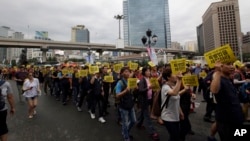A man whose 17-year-old child was killed in the April sinking of a South Korean ferry, the country's worst maritime accident in decades, said he is ready to move on, tired of the political wrangling and mud-slinging four months after disaster struck.
But his nerves were on edge. He didn't want his name used and was wary of being overheard while taking a cigarette break during a meeting of grieving families.
“Everyone is getting exhausted. Most of us like me want to see some kind of closure,” he said on Wednesday night in Ansan, the working class city southwest of Seoul where most of those killed in the disaster had been pupils at Danwon High School.
Families who lost loved ones in the tragedy are demanding accountability from the government, but many have grown weary of strident activists adopting their cause for political ends.
The overloaded Sewol capsized and sank on a routine voyage that killed about 300 people, most of them children from the same school, causing an outpouring of grief as well as outrage at President Park Geun-hye's conservative government for what was widely seen as a botched rescue operation.
Four months later, the tragedy is so politically charged that Pope Francis had to answer for wearing a yellow ribbon in support of the victims during his visit to Seoul.
Some family members have tired of the political to-and-fro over proposed legislation to create an independent investigative committee with the right to prosecute. The People's Committee for the Sewol Ferry Tragedy, which supports mourning families, consists of more than 800 civic groups, many of them already critics of Park.
Another father of a victim said some family members did not want left-wing activists helping them, as it compromised their political neutrality.
“Some of us didn't want to mingle with them, but at that time we were office workers who didn't know how to speak up for ourselves,” he said. “So I thought we needed their support.”
The mother of a victim, who declined to be identified outside the meeting in Ansan, said she had had no choice but to defer to those championing their cause.
“It is somewhat burdensome that those civic groups are helping us and some people [not tied to the disaster] speak ill of us. But as a mother who lost her child, I have no choice but to follow people who are active in our group because they are doing something that I can't do,” she said.
At Wednesday's meeting in Ansan, households backed their initial position calling for an investigative committee, with 132 out of 176 voting to stick with that demand, rejecting for the second time a bipartisan compromise reached by the country's two main political parties.
'I have a headache'
At a makeshift camp of victims' supporters in the center of Seoul, a father had been on hunger strike but many of more than 100 people gathered on a morning this week appeared to be left-wing activists.
Among the posters and banners at the protest site, one says: “Why is the [presidential] Blue House trying to kill Yu-min's father? President Park Geun-hye, come out and take responsibility!”
Activists have rallied around Yu-min's father, Kim Young-oh, 47, who lost his 16-year-old daughter in the disaster and was fasting, living off water and salt, before being taken to a hospital on Friday, the 40th day of his hunger strike.
“I have a headache. I have a headache because of politicians in South Korea,” Kim said on Wednesday after the leader of the main opposition party visited him after the latest attempt at legislation to investigate the disaster fell short of what many of the victims' families have been demanding.
“We want to find why more than 300 people died unfairly. We want to clarify this and hold a person in charge accountable,” said Kim, who handed a letter to Pope Francis on Saturday before a massive open-air Mass in Seoul.
Politically polarized
South Korea, after decades of armed standoff with the reclusive, nuclear-armed North and entrenched regionalism, has long been politically polarized. Protest groups and demonstrators, and a heavy police presence, are a staple of everyday life in downtown Seoul, and some among the ferry families' victims and their supporters have complained of overzealous treatment by police.
The Korean Confederation of Trade Unions, one of the country's largest labor groups and known to take up causes beyond workers' rights, is among those supporting the families.
“Aside from the differences between opposing parties, there is a public consensus into building a safer society. We just want an independent investigation into what happened, but are accused of politicizing it ... it's become politically distorted,” said confederation spokesman Park Sung-shik.
Kim Hong-cheol, director general of the Citizens' Movement for Environmental Justice, another backer of the families, said it joined the cause because it supports safety and security and bemoaned the political wrangling.
“It is just a simple request of those distraught parents who want to know why their children died. There is nothing political about that,” he said.
The pope, meanwhile, was asked during his return flight to Rome this week about the yellow ribbon he wore in support of the ferry victims.
“I took this ribbon ... out of solidarity with them, and after half a day someone came close to me and said: 'It is better (you) remove it, you should be neutral,”' he said.
“But listen, one cannot be neutral about human pain. I responded in that way. That's how I felt.”












